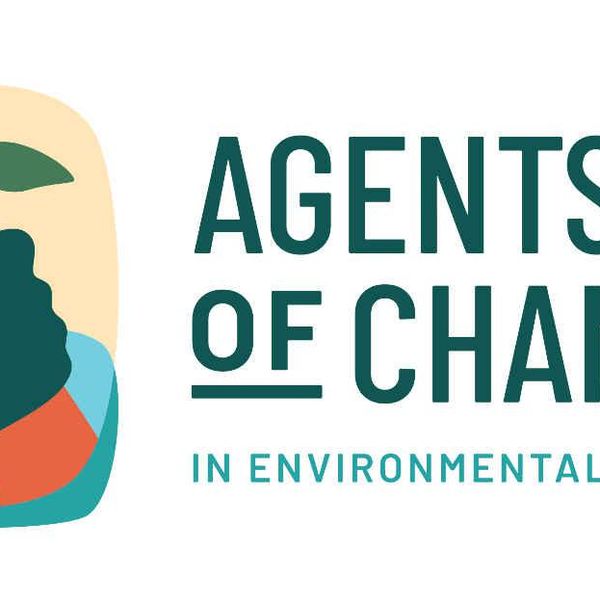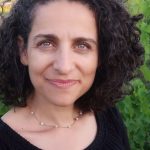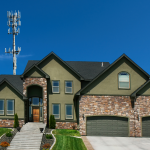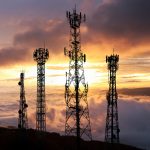
Lorraine N. Vélez-Torres joins the Agents of Change in Environmental Justice podcast to discuss fungal spores and why they are an acute problem in Puerto Rico.
Vélez-Torres, an Agents of Change fellow and microbiology PhD Candidate at the University of Puerto Rico – Medical Sciences Campus, talks about asthma rates in the island, and how public health officials can better protect people in post-hurricane recovery efforts.
The Agents of Change in Environmental Justice podcast is a biweekly podcast featuring the stories and big ideas from past and present fellows, as well as others in the field. You can see all of the past episodes here.
Listen below to our discussion with Vélez-Torres, and subscribe to the podcast at iTunes, Spotify, or Stitcher.
Transcript
Brian Bienkowski
Today’s guest is Lorraine Vélez-Torres, an Agents of Change fellow and microbiology PhD candidate at the University of Puerto Rico, medical sciences campus. Torres talks about fungal spores and why they are an acute problem in Puerto Rico and how public health officials can better protect people in post-hurricane recovery efforts. Enjoy.
Alright, I am super happy to be joined by Lorraine Vélez-Torres. Lorraine, how are you doing today?
Lorraine N. Vélez-Torres
I’m doing great, Brian, how are you?
Brian Bienkowski
I’m doing wonderful. And where are you today?
Lorraine N. Vélez-Torres
I’m in San Juan, Puerto Rico, in my apartment. I decided to stay in today for this interview.
Brian Bienkowski
Excellent. Excellent. What a beautiful place. I’ve never been there, but I want to visit so badly, that is on my list.
Lorraine N. Vélez-Torres
You should come. It’s beautiful. It’s amazing. The people’s amazing. The food is amazing. So you have to, you have to come.
Brian Bienkowski
So you were born there. You were born in Puerto Rico, and describe to me the place that you’re from and anything about it that you think shaped the person you are today.
Lorraine N. Vélez-Torres
Yeah. Well, I grew up in Yauco, Puerto Rico, but I was born in Ponce. Yauco is more commonly known as the coffee town because of the higher number of coffee plantations in the area. And this town is located in the southwest region of Puerto Rico. It is usually very dry and warm, in terms of the climate, and I just wanted to bring some interesting facts about the land acknowledgement about the Taíno people and Yauco. And, Yauco was named after the Yauco river which itself comes from the Taíno words Coayuco, meaning cassava plantation. And also the Taíno natives consider Yauco the area of, or the capital of Boriken, which is how they called Puerto Rico, and governed by Agüeybana, the most powerful cacique in the island.
Brian Bienkowski
You mentioned coffee. So is there, is coffee a big growth plant there? And if so, did you start drinking it at like a very young age? Because it was everywhere?
Lorraine N. Vélez-Torres
Yes, coffee is part of our culture in Puerto Rico and more in Yauco, so I drink it since I was little, always. My parents made this for me, and I’ll take a sip. And today or nowadays, I always drink it every day. We also have like a coffeemaker at the lab, it’s very, very, we need that, we need it.
Brian Bienkowski
So do you, last coffee question, do you drink coffee that’s grown right there in the region? Or do you get it from? What coffee are you drinking?
Lorraine N. Vélez-Torres
Yes, the coffee is from Puerto Rico. Not from Yauco, but from Puerto Rico, my favorite one.
Brian Bienkowski
Excellent. That’s excellent. And you, so I read that you said you fell in love with research at something called the symbiosis laboratory. My first question is, what is a symbiosis laboratory, and what about that experience, if you could tell us about it, made you want to pursue research as a career?
Lorraine N. Vélez-Torres
Well, in my third year, as an undergraduate student, I had the opportunity to work in the symbiosis laboratory of Dr. Matias Cafaro. And a symbiosis laboratory studies the relationship between two or more biological species. In this case, for my undergraduate research, I studied the relationship between actinobacteria bacteria and termites, and more specifically, I studied how this actinobacteria that were growing in the termite exoskeleton helped the termites fight fungal pathogens by producing antifungal secondary metabolites. And this was like an amazing experience. I began to do research on my own I, I learned about mentorship, about analyzing results, and most importantly for me, about presenting those results to the community at local and national meetings.
Brian Bienkowski
That’s amazing to have that experience as an undergraduate. I know, I didn’t even know what a scientific paper was until I was in my master’s program, which is embarrassing to admit as a science journalist. But it’s just not something that was taught or really explained to us. So I’m wondering, how did that manifest in talking to the community, was the research that you were learning about in the laboratory something you talked to community about? Or was that engagement and training something separate?
Lorraine N. Vélez-Torres
Initially, I shared my research with the scientific community. And then throughout my master’s, and more specifically, in my doctoral studies, I had the opportunity to share this science with the general public and with students, but initially it was just at, to the scientific community.
Brian Bienkowski
Great, and we will, we will talk about some of the research you’re doing now and some of the community engagement, but first, I wanted to find out what is a defining moment or event that shaped your identity up to this point?
Lorraine N. Vélez-Torres
Well, that’s a tough question. I think that I have more than one defining moment in my life. And one of them is when I decided to pursue a PhD in microbiology instead of a medical career, a doctoral in medicine. And this decision came when I graduated from my bachelor’s in microbiology. I did a one year master’s in public health with a concentration in epidemiology. And the goal for me was to after finishing my master’s just going to med school. But once I did research in my master’s in public health, I began thinking that through research, you can reach and impact a population as a whole. And as a medical doctor, you can you do it individually, in like one patient at a time. And that’s when I decided, I always say, to go back to my roots, to go back to microbiology and do research, but in this in this time on the biomedical sciences, or biomedical area.
Brian Bienkowski
So you are researching something that was brand new to me. I learned about this when I was editing an essay you wrote for us. And so you are researching the effects of Hurricane Maria in Puerto Rico and what it had on indoor fungal spore concentrations. So, first off, tell us what are fungal spores and why are they a problem?
Lorraine N. Vélez-Torres
Yes, that is part of my research thesis. And to answer your question, fungal spores are like tiny, very microscopic seeds that, under the right conditions, can become any fungus. So they allow fungal reproduction. They pose a problem for respiratory health, because since they are very small, they can gain the, access your respiratory, upper and lower respiratory tract. And there they can exacerbate either allergic rhinitis, asthma and other inflammatory respiratory conditions.
Brian Bienkowski
And so what have you found so far in terms of how Hurricane Maria impacts fungal spore communities and prevalence in the region?
Lorraine N. Vélez-Torres
Well, we have found very interesting results on fungal spore concentrations and on the fungal communities present in the home sample in the aftermath of the Hurricane Maria. And just to explain a little bit of how we did this research: We took our samples from homes that were categorized by different degrees of water exposure 12 and 22 months after Hurricane Maria. And we have found an interesting switch in the fungal populations present in these homes, and particularly between dry and flooded homes. And this switch is persistent, almost two years after the hurricane. So we think that these results can be very helpful in the development of guidelines for post-flood recovery and also to prevent exacerbations of asthma, allergies and other respiratory conditions. And we recently submitted the manuscript in a peer-reviewed journal so we are hoping it gets accepted, and you can all read it.
Brian Bienkowski
Excellent. And I should have asked this first. But, when we’re thinking about Puerto Rico and fungal spore concentrations, from what I understand it’s, it’s more of a problem there than in a lot of other places and hurricanes certainly play into that. I’m wondering if you could talk about why it’s more of a problem where you’re at and say where I’m at here in the northern United States?
Lorraine N. Vélez-Torres
Yes, that’s a great question. Thank you. So first of all, here in Puerto Rico, we have the highest asthma rates, when compared to the U.S. And also it’s very important that since fungal spores are very tiny and microscopic, we cannot see them. And we breathe millions and millions of fungal spores daily. And we breathe even more here in Puerto Rico, because we have also high levels, extremely high levels of fungal spores in our air, in our environment. Maybe due to the different circumstances and environmental conditions that we have: high humidity levels, flood prone conditions, and the Caribbean, location in the Caribbean, can create this higher concentrations of fungal spores in the air. And this is very problematic for asthma, because specifically, the fungal spores that are less than 2.5 microns can enter your lower respiratory tract and there, they can trigger those asthma symptoms or exacerbate those asthma symptoms. And here in Puerto Rico, we have those high prevalences more specifically in our children, where they have twice the prevalence in Puerto Rico when compared to the U.S. children.
Brian Bienkowski
So a lot of environmental problems we think of a very clear bad guy, we think of, you know, pollution or greenhouse greenhouse gas emissions, we can point to a polluter or a oil and gas company. But fungal spores are natural. So it’s a lot, we can’t we can’t point our finger at somebody. So what do you see as some of the solutions or prevention strategies to keep people in Puerto Rico from inhaling these spores and exasperating, exacerbating some of the respiratory symptoms?
Lorraine N. Vélez-Torres
Yeah, you’re right. In this case, the bad guy are fungi and we cannot kill all the fungi in Puerto Rico. So the first solution that I have is education, is educating our community to know about the fungal spore conditions in Puerto Rico. And more importantly know about them, but because, since they are microscopic, we cannot see them. We are not aware of their existence. And we are only aware if we see visible, visible mold growing in our home or if we smell that moldy characteristic other. But otherwise, we are not aware that we are breathing millions and millions of fungal spores daily. So the education is key. And one thing that we can do is know about the fungal patterns in the island. And here I want to bring out the work of my mentor, Dr. Benjamin Bolaños, he has been working throughout his life here in Puerto Rico. He established the aero-allergen station in San Juan Puerto Rico, which is certified by the National Allergen Bureau from the American Academy of Asthma, Allergy, and Immunology. And he has been working 24/7 throughout the past 16 years, so that the Puerto Rican population can use this information to manage their asthma symptoms. And you can manage them by knowing these patterns. And the first pattern is that there is a calendar of fungal spores in Puerto Rico with the highest fungal spore concentrations being shown in the rainy months of September to November. Also, fungi have a circadian rhythm. They have like a 24-hour cycle with the highest fungal spore levels during the early morning hours in the night while we sleep. So we recommend to use an air purifier with a HEPA filter while you sleep. So that way you limit the exposure to these fungal particles. And finally fungal spores also increase after the rain. So we recommend that if you do not have to go out after the rain you, you don’t, you don’t do it. And this information can first help asthmatic patients to identify if fungal spores are one of their triggers. And if they are, then they can, this information can help them manage their symptoms during these high levels of fungal spores.
Brian Bienkowski
So I know you’ve physically gone into the homes of some folks after Hurricane Maria and engage with the public as part of your research and I’m wondering if you’ve got communicated your research at all to those communities in Puerto Rico and other non-scientists? And if so, maybe some tips you have, you know, how did it go? And what are some other science communication strategies that you have, for people who are wanting to have more community engagement on the back end of the research?
Lorraine N. Vélez-Torres
Yes, I have communicated my research. And this is one of my favorite parts of science, I love science communication. And I have communicated my research findings to students from all levels, with the hopes of making science more accessible, more interesting and fun for the future generations. And we are also interested, in the group of my research, to communicate these results with the community that opened their doors for us, that help us to make this research and find these things. But due to COVID, we haven’t been able to do to do that, because it’s a low-income community, so many of these science communication opportunities occurs with internet with presentations online. So that’s not possible. But we are hoping to go back to the community and make an activity to show them the results and help them use this information to their benefit and to benefit their health. And in terms of science communication tips, I have some, I have five tips. The first one is to know your audience. Ask yourself, who am I giving this presentation to? Who am I communicating this information? Are they fellow scientists or general public, friends, family, students, what is their level of education? And then try to create that presentation for them. The second, the second tip is to know your goal. You can have more than one goal, and that could be share your findings, educate, advocate, create awareness, and encourage change. And you shall know your goals for your presentation. The third, the third tip is to be able to tell your message in a short and concise way. And for this, you can practice with an elevator pitch. Or you can also practice by telling your message in one minute, in under 30 seconds, 15 seconds, eight seconds, it’s a great exercise to tailor your message. The fourth tip is to avoid jargon. This is some, sometimes very difficult, you can use technical words, but do try to define them. And the last tip is to be relatable. Try to tell a story about yourself. Use some analogies, try to humanize science and the scientists. And by that by that way you will connect better with your audience.
Brian Bienkowski
Yeah, those are excellent tips. You know, I really like the very first one of knowing your audience. I mean, sometimes I would imagine as a scientist, it makes sense to have different, different messages, strategies written down for different audience—obviously a policymaker, as opposed to a mother, a father, a concerned mother or father, that’s going to be vastly different messaging. So that’s a really good place to start. And those are great tips.
Lorraine N. Vélez-Torres
Thank you.
Brian Bienkowski
So you have a, you are the co-founder of something that I’m going to try to pronounce. Let me see how I do here. Vistazo A La Ciencia.
Lorraine N. Vélez-Torres
Yes. That was great. That was great
Brian Bienkowski
Vistazo A La Ciencia, which means science at a glance. So tell me what this is and what are you all doing there?
Lorraine N. Vélez-Torres
Yes, Vistazo A La Ciencia, I’m the co-founder and mentoring director. This is a nonprofit organization that aims to eliminate barriers between science and the Puerto Rican population or Hispanic population. And we try to make science available, understandable, and that way the citizens can make decisions that contribute to their personal, intellectual wellbeing. And we do this by different strategies, specifically by livestream interviews with experts, and we also make collaborations with other science organizations, and we also mentor students. We are a team of four: Dr. Rivera-Mariani, which is one of my mentors and member of my thesis committee; Albersy Armina Rodriguez which is my friend and colleague, I met her through the PhD studies; and Andrea Semidei-Rodriguez is an undergrad student, and she became part of the team recently, she’s also my cousin. And well, Vistazo A La Ciencia was founded in May of 2020, during the pandemic, because we saw that there were many science organizations, but they were talking only about COVID-19 pandemic, and we wanted to talk about science in general. And we have made over 60 live interviews with experts in different topics like COVID-19, public health, mental health, diabetes, cancer research, exercise, among other topics. We are currently having a collaboration with another science organization called STEAM100x35. And they work for the visibility of Puerto Rican woman in STEAM, in science, technology, engineering, arts and math. And we also have a series that is called Mentees on the Spotlight, where we are interviewing students about their research, their mentoring experience, and their tips for other students and fellow researchers. And currently, I’m also organizing a series of professional development workshops for undergraduate students from the private organization at UPR campus. And, obviously, Vistazo A La Ciencia has been an amazing opportunity of growth. I have learned a lot about different topics outside my research area, and also about science communication. And today, I was telling you that the tables were turned because I’m usually the one asking the questions and now I’m here. Now I’m here and it’s been very different and refreshing. So thank you.
Brian Bienkowski
So as a fellow interviewer, how am I doing?
Lorraine N. Vélez-Torres
Ah, you’re doing great, I love your questions.
Brian Bienkowski
That’s great to hear. And we will definitely put a link to Vistazo A La Ciencia into, into this podcast post so people can check that out. And you know, one of the things that struck me about your research is, when I think of, sometimes I wish I would have went into science and I, I would love to go into like, you know, trout or something, you know, like a fish that I love. And I’m wondering what it is like being a fungi scientist and if you ever thought you’d be doing that?
Lorraine N. Vélez-Torres
Wow, I never thought so. I worked with fungi in my undergrad research because they were killing the termites and the Actinobacteria were helping them. And I knew about fungi first there and then I took a mycology class and a medical mycology and economy mycology, and I loved them. But then during my PhD studies, I initially was researching viruses, because that’s what I liked. I found them fascinating. But then I changed my mind. I went to the lab of Dr. Benjamin Bolaños and fungi, I love them. My favorite is Aspergillus. I’m very biased because he’s one of the important characters of my research. And I love them. They are beautiful. They are very challenging. I, sometimes they are very bad to me. They do not grow. But I love them. I love them.
Brian Bienkowski
So perhaps this is a dumb question. But do you have to wear protective respiratory equipment when you work with some of these fungi?
Lorraine N. Vélez-Torres
Ah, I don’t. I do now, because, since we’re in COVID times, we always use the mask. But I usually don’t do it. My mentor doesn’t also, but my other colleague and MS student in the lab, when I begin working with the fungi and opening the plates, she will get allergies. I think I’m good.
Brian Bienkowski
So I’m assuming the spores are not, they’re not present when you’re working with the actual fungi.
Lorraine N. Vélez-Torres
Well, once you touch the fungi, the spores will spread. And you will definitely smell them and get them on your respiratory tract. So you should usually use that. But maybe I’m not that sensitive or allergic to them, to the ones I work with.
Brian Bienkowski
Right. Gotcha. And I have two more questions for you. And one of them is, do you, you know, looking forward in your career, you’ve stayed in Puerto Rico, I know you’re not right where you were born, but you’ve stayed in the area there. Do you plan on kind of staying in Puerto Rico to pursue research and keep working with communities there?
Lorraine N. Vélez-Torres
Yeah, that’s the goal. I will love to give back to my community, to my population and fellow Puerto Ricans. That’s the goal. I would love to train outside and go when, maybe do a postdoc outside and then come back to my island—I’m very family oriented. We’re very close. So I will love to stay here in Puerto Rico.
Brian Bienkowski
That’s excellent. I don’t know if you saw it, but we had a woman from Puerto Rico Abrania Marrero, yeah, who wrote, she wrote an essay for Agents of Change, which is one of my favorites. And it had just, it was kind of almost like a love letter to the island. And it was really beautiful. So I know where you’re coming from, from having read her, read her piece. So Lorraine, this has been so much fun. My last question is, what is the last book that you read for fun?
Lorraine N. Vélez-Torres
Well, I’m not much of a reader since I read so much for science. But the last book I read goes very well with the season. And it was Dracula by Bram Stoker. I love. Yeah, I love all kinds of horror stories.
Brian Bienkowski
Yes, yes. We all need a diversion from the work we usually do, the environmental stuff. Well, Lorraine, I think that siren means the podcast is over, the streets of San Juan have spoken. Thank you so much for being here today. I really appreciate it.
Lorraine N. Vélez-Torres
Thank you so much for this opportunity was so amazing.





